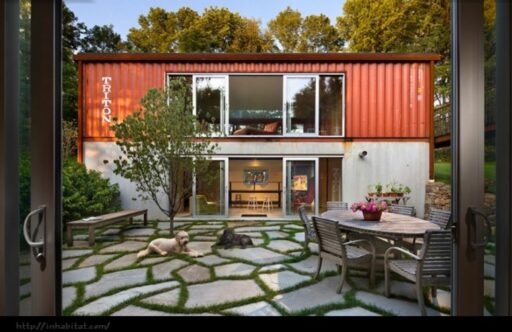In the evolving landscape of construction and architecture, the Design-Build model has emerged as a revolutionary approach that combines the expertise of architects and contractors to streamline the building process. This integrated method not only enhances collaboration but also optimizes efficiency and fosters innovation, leading to projects that are completed on time, within budget, and to the satisfaction of all stakeholders. By examining the rise of Design-Build contractors and their impact on the industry, we can understand how this approach is reshaping the future of construction.
Key Takeaways
- The Design-Build model represents a shift from the traditional design-bid-build process, fostering a more collaborative and efficient approach to construction.
- Early contractor involvement in the Design-Build process allows for real-time cost assessments and proactive issue resolution, aligning design plans with budget and timeline.
- Open communication and a multidisciplinary team structure are central to the Design-Build philosophy, leading to innovative solutions and a unified vision of success.
- Design-Build projects benefit from shortened timelines and the use of cutting-edge technologies like BIM modeling, which streamline construction processes.
- The growing popularity of the Design-Build approach signals a transformative shift in the construction industry, with an emphasis on collaboration and integrated practices.
Understanding the Design-Build Model

The Integrated Approach to Construction
The Design-Build model represents a paradigm shift in the construction industry, where the traditional silos of architecture and construction merge into a cohesive workflow. The integrated approach to construction not only enhances collaboration but also ensures that design and build phases are seamlessly interconnected, leading to more efficient project delivery.
Key benefits of this model are evident in the way projects are executed. For instance, in Dubuque, the Design-Build model promotes collaboration, transparency, and superior outcomes. Accurate cost estimates, timely completion, and trust-building through personal connections are just a few of the advantages that stakeholders experience.
The synergy between architects, engineers, and builders in the Design-Build process fosters a unified vision, which is critical for the project’s success. This collective mindset is instrumental in overcoming challenges and achieving the desired results.
Innovation and cutting-edge technologies are integral to the success of Design-Build projects. With tools like BIM modeling, the coordination and streamlining of construction processes are greatly enhanced. This not only optimizes efficiency but also minimizes potential pitfalls, ensuring a smooth transition from design to execution.
Advantages of Early Contractor Involvement
The early involvement of contractors in the Design-Build process is a game-changer for project success. It facilitates real-time cost evaluations and constructability assessments, which are crucial for proactive issue resolution. This collaboration from the start fosters a mutual understanding between architects and contractors, leading to design plans that are both accurate and in line with the project’s financial and temporal constraints.
By integrating contractors early on, the project benefits from their expertise during the crucial design phase, ensuring that the final outcome is not only feasible but also optimized for quality and efficiency.
Moreover, this early engagement promotes open communication, allowing for a shared vision and objectives to be established among all stakeholders. It is a proactive approach that minimizes the risk of misunderstandings and aligns the final design with the owner’s vision, ultimately reducing the likelihood of costly and time-consuming change orders.
Streamlining Decision-Making Processes
The Design-Build model enhances decision-making efficiency by unifying the project team. This integration allows for a more agile response to changes and challenges, reducing delays and maintaining project momentum.
- Rapid adaptation to unexpected circumstances
- Cohesive unit of architects and contractors
- Single point of contact for the owner
The agility of the Design-Build team in decision-making ensures smooth project progression, even when facing unforeseen obstacles.
By fostering a systems-driven design approach, the Design-Build method streamlines communication, minimizes errors, and ultimately leads to cost savings. This approach opens up dialogue between all stakeholders, ensuring that everyone is on the same page and working towards a common goal.
Collaboration at the Core of Design-Build

Fostering Open Communication
In the design-build model, open communication is the cornerstone that holds together the intricate relationship between all parties involved. The continuous exchange of ideas and feedback among the owner, architects, designers, contractors, and subcontractors is not just encouraged but is integral to the project’s success. This collaborative environment ensures that each stakeholder’s perspective is heard and valued, leading to a unified vision and a project that truly reflects the owner’s objectives.
Effective communication strategies are embedded into the company culture of design-build firms. Regular Owner-Architect-Contractor (OAC) meetings are a testament to this, where the core team and trade partners come together to discuss progress and align on goals. Such practices are pivotal in maintaining a smooth transition from design to construction, with the design team providing comprehensive briefings to the production team. This proactive approach minimizes misunderstandings and facilitates a seamless process that anticipates and addresses potential issues.
By fostering a culture of trust and transparency, design-build contractors create a partnership with their clients. This is achieved through consistent updates, open dialogue, and a commitment to addressing concerns promptly. The result is a project that not only meets the scheduled timelines and budget but also exceeds client expectations with a final product that is free of surprises.
The Multidisciplinary Team Advantage
The multidisciplinary team structure inherent in the Design-Build model is a cornerstone of its success. By bringing together diverse professionals—architects, engineers, contractors, and specialists—each project benefits from a wealth of knowledge and expertise. This collaborative environment is not just about pooling skills but also about creating a synergy that leads to greater innovation and efficiency.
- Architects and engineers provide the vision and technical know-how.
- Contractors and specialists contribute practical insights and hands-on experience.
- Together, they form a cohesive unit capable of tackling complex challenges and delivering high-quality results.
The streamlined decision-making process is another significant advantage of the Design-Build approach. In a traditional model, architects and contractors might work independently and occasionally find themselves at odds when faced with complex design or construction challenges. Conversely, Design-Build teams work as a cohesive unit, able to make rapid decisions and adapt to unexpected circumstances efficiently.
The use of tools like BIM technology allows multidisciplinary teams to collaborate effectively by providing a shared virtual platform to visualize, design, and manage projects. This not only accelerates timelines but also enhances the overall quality of the construction.
Building a Collective Vision for Success
The design-build model thrives on the synergy of a unified team, where architects, contractors, and clients work together to create a shared vision. Balancing creativity and budget, we create timeless designs that reflect clients’ visions. This collaborative process ensures functional, stylish spaces tailored to individual needs, fostering a high-trust, high-collaboration environment.
Continuous improvement is a hallmark of the design-build approach. Each project’s lessons contribute to refining processes and fostering innovation, laying the groundwork for future successes.
Key focus areas for a successful design-build firm include:
- Retaining and developing talented staff through culture and mentorship
- Emphasizing respect and transparency to create camaraderie
- Involving staff in company decisions to encourage ownership and thrive
These principles are crucial for cultivating a positive and productive work environment, leading to high-performing teams that are essential for the road to success.
Efficiency and Innovation in Design-Build Projects

Shortening Project Timelines
The design-build approach is renowned for its efficiency, particularly in shortening project timelines. By overlapping the design and construction phases, not only is the overall project duration reduced, but it also allows for construction to begin while the design is still being refined. This concurrent progression is a stark contrast to the sequential steps of the traditional design-bid-build model, where one phase must be completed before the next can commence.
In practice, this means that clients can expect earlier completion dates and a quicker transition to occupancy. The design-build model facilitates a seamless flow of work from conception through to completion, minimizing delays and enhancing productivity. The table below illustrates the typical time savings achieved through the design-build process compared to traditional methods:
| Phase | Design-Build Duration | Traditional Duration |
|---|---|---|
| Design | 3-6 months | 6-12 months |
| Construction | 6-9 months | 9-15 months |
| Total | 9-15 months | 15-27 months |
The collaborative nature of design-build not only expedites the project timeline but also ensures that the client’s priorities are at the forefront throughout the project lifecycle. This client-centered focus is a key factor in the growing popularity of design-build contractors.
Leveraging Cutting-Edge Technologies
In the realm of design-build projects, the strategic integration of cutting-edge technologies is a game-changer. Cloud-based solutions are at the forefront, offering a suite of advanced features that enhance collaboration and efficiency. These include artificial intelligence (AI), big data analytics, and the Internet of Things (IoT), which together create a powerful ecosystem for project management.
The migration to cloud-based platforms is not merely a technological shift but a strategic transformation that arms design-build contractors with the tools necessary for innovation and competitive edge.
Adoption rates of various technologies are indicative of the industry’s direction. For instance, the use of cloud-based Construction Management Software (CMS) is expected to rise significantly. Here’s a snapshot of the current and projected adoption rates in the US:
- 2023: High adoption of cloud-based CMS, AI integration beginning to take hold.
- 2026: Predicted to see a substantial increase in AI-driven analytics and IoT implementations.
By embracing these technologies, design-build contractors can streamline processes, reduce risks, and deliver projects with greater precision and sustainability.
Minimizing Risks Through Integrated Practices
The design-build model inherently reduces project risks by fostering a unified approach to construction. Construction contractors, consultancies, and architects play vital roles in project success by managing risks, adopting technology, and ensuring quality and sustainability in the built environment. By integrating practices, these stakeholders can anticipate and mitigate potential issues before they escalate.
Embracing integrated platform solutions with advanced functionalities is key to minimizing risks. These platforms can streamline the construction management process, enhancing risk mitigation and improving project planning, maintenance, site safety, and communication.
The application of AI and automation is a game-changer in risk management. These technologies allow for real-time identification, analysis, and response to potential risks, which enhances decision-making and operational efficiency:
- AI and automation improve safety protocols and cost management.
- They enable proactive risk assessment and management throughout the construction lifecycle.
- Integration of these tools leads to better sustainability practices and resource management.
Comparative Analysis: Design-Build vs. Design-Bid-Build

Contrasting Project Management Approaches
The procurement method chosen for a construction project significantly impacts its overall success, affecting factors such as cost, schedule, quality, and team dynamics. Design-Build and Design-Bid-Build represent two distinct project management approaches with inherent differences in how projects are delivered.
In the Design-Bid-Build model, the project is distinctly segmented into separate phases: design, bidding, and construction. This traditional approach often leads to a linear and sometimes disjointed process, where each phase must be completed before the next begins. On the other hand, the Design-Build method integrates these phases, allowing for concurrent design and construction activities, which can lead to more efficient timelines and cohesive team collaboration.
The Design-Build approach fosters a unified project team from the outset, enhancing communication and aligning goals across all disciplines involved.
A comparison of these methodologies reveals the following contrasts:
- Design-Bid-Build: Sequential phases, multiple contracts, and potential for siloed communication.
- Design-Build: Simultaneous phases, single contract, and integrated communication.
By understanding these differences, stakeholders can make informed decisions that align with their project goals and priorities.
Benefits of a Unified Team in Design-Build
A unified team in Design-Build streamlines the entire construction process, from initial concept to project completion. The collaboration between architects, contractors, and other stakeholders from the early stages fosters a shared vision and mutual understanding, which translates into numerous project benefits:
- Enhanced communication ensures that all parties are on the same page, reducing the likelihood of costly misunderstandings.
- Integrated problem-solving allows for innovative solutions, as diverse expertise is pooled to address challenges collaboratively.
- Efficiency in decision-making is achieved by eliminating the back-and-forth typically seen in traditional models, speeding up the project timeline.
The synergy of a unified team not only optimizes the workflow but also imbues the project with a sense of shared purpose, driving towards a successful outcome with a cohesive strategy.
Furthermore, the involvement of contractors early in the design phase leads to more accurate budgeting and scheduling. The table below illustrates the impact of this early contractor involvement on project efficiency:
| Aspect | Traditional Model | Design-Build Model |
|---|---|---|
| Decision-making time | Longer | Shorter |
| Budget accuracy | Lower | Higher |
| Schedule adherence | Less likely | More likely |
By embracing the Design-Build approach, project teams can leverage these benefits to deliver higher quality results within tighter budgets and schedules.
Challenges of the Traditional Design-Bid-Build
The traditional Design-Bid-Build (DBB) model, while well-established, presents several challenges that can impact the success of a construction project. One of the primary issues is the fragmented approach to project delivery. Architects, contractors, and subcontractors often operate independently, leading to separate contracts and a lack of unified direction.
In this model, the design phase is completed before contractors are invited to bid. This sequence can result in scheduling conflicts and a need to revisit designs if they exceed budget constraints, causing delays and increased costs.
Another significant challenge is the potential for communication gaps between the various parties involved. Without the collaborative environment fostered in the Design-Build approach, these gaps can lead to misunderstandings and discrepancies in project objectives. Moreover, the traditional method may lead to a cost uncertainty as the lowest bidding contractor may not always account for all project complexities, potentially resulting in quality compromises or additional expenses down the line.
The Future of Construction: Embracing Design-Build

The Growing Popularity of Design-Build
The Design-Build approach is rapidly gaining traction in the construction industry, as it presents a unified method where architects and contractors collaborate from the very beginning. This early involvement of contractors is crucial for real-time cost evaluations and proactive issue resolution, ensuring that design plans are both accurate and aligned with the project’s financial and temporal constraints.
The efficiency of the Design-Build model is further underscored by its streamlined decision-making process. Unlike the traditional design-bid-build system, where independent work can lead to conflicts, Design-Build teams operate as a single entity, capable of swift and effective adaptations to any project challenges.
The Design-Build model’s collaborative nature not only enhances project outcomes but also fosters a culture of innovation and excellence within the industry.
As the model continues to demonstrate its value, more industry professionals are adopting Design-Build practices. For instance, members of the NTRCA (North Texas Roofing Contractors Association) are experiencing the benefits of this approach, which includes access to industry insights, resources, and innovative project delivery methods like progressive design-build.
Anticipating Industry Shifts
As the construction industry approaches 2024, experts are forecasting transformative changes. These predictions, shared by over 30 thought leaders, suggest a dynamic shift towards embracing digital technologies and innovative practices. The anticipation of these shifts is not just speculative; it’s informed by current trends and the strategic positioning of companies that are already adapting to the evolving landscape.
Investors and companies alike are advised to identify and support innovations that align with these industry movements. A focus on cloud-based integrated platforms, generative AI, and sustainability is crucial. Companies that demonstrate a clear understanding of these trends are likely to gain a competitive edge as the adoption of Construction Management Software (CMS) increases.
The integration of emerging technologies is not a mere possibility but a strategic imperative. Companies that proactively adapt to these changes are positioning themselves to outpace the competition and secure a foothold in the next-generation construction landscape.
The table below outlines the expected technology adoption by US contractors, highlighting the shift towards cloud-based solutions:
| Technology Type | Adoption in 2023 | Expected Adoption in 2026 |
|---|---|---|
| Cloud-Based Solutions | Moderate | High |
| Generative AI | Low | Moderate |
| Sustainability Practices | Moderate | High |
These anticipated industry shifts are not only about adopting new technologies but also about transforming the way we think about construction, design, and collaboration.
Preparing for a Collaborative Construction Landscape
As the construction industry pivots towards a more integrated and collaborative model, professionals must adapt to the evolving technological and operational landscapes. The shift towards comprehensive, user-friendly platforms is indicative of the industry’s consolidation strategy, aiming to streamline processes and enhance efficiency across all stages of construction.
The Design-Build model’s emphasis on collaboration is not just a trend but a strategic approach that is reshaping the industry. It fosters a high-trust, high-collaboration environment that can lead to innovative solutions and a shared commitment to project success.
To prepare for this shift, industry stakeholders should consider the following steps:
- Embrace continuous learning to stay abreast of emerging technologies and methodologies.
- Cultivate a culture of open communication and interdisciplinary teamwork.
- Reevaluate and potentially restructure organizational processes to align with collaborative project delivery methods.
The table below highlights the key benefits of a highly collaborative Design-Build environment:
| Benefit | Description |
|---|---|
| Accelerated Timelines | Fast-tracked schedules due to overlapping design and construction phases. |
| Enhanced Communication | Regular meetings and proactive strategies keep stakeholders aligned. |
| Innovative Solutions | Shared insights and expertise lead to creative problem-solving. |
| Ownership and Commitment | A collective drive for success among all team members. |
By anticipating these industry shifts and preparing accordingly, construction professionals can position themselves at the forefront of a more efficient, innovative, and collaborative future.
Embracing the Future: The Integrated Path of Design-Build
The evolution of the construction and architecture industries has been marked by a transformative shift towards the Design-Build approach, a model that exemplifies the power of integration. By fostering a collaborative environment from the onset of a project, this approach has proven to be a catalyst for efficiency, innovation, and overall project success. The seamless union of architects and contractors under the Design-Build model not only streamlines the process but also enhances communication, reduces timelines, and ensures that the final outcome aligns with the client’s vision. As we look to the future, it is clear that the rise of Design-Build contractors is not just a trend but a paradigm shift that is redefining the landscape of construction and architecture, promising a more cohesive, dynamic, and successful path forward.
Frequently Asked Questions
What is the Design-Build model in construction?
The Design-Build model is an integrated approach to construction that brings architects and contractors together from the early stages of a project to work hand-in-hand. This method promotes collaboration, efficiency, and innovation, allowing for real-time cost evaluations, constructability assessments, and a unified project vision.
How does Design-Build differ from the traditional design-bid-build approach?
Unlike the traditional design-bid-build approach, where architects design the project first and then contractors bid to build it, Design-Build involves both parties from the beginning. This early collaboration can lead to more accurate designs, cost savings, and streamlined decision-making processes.
What are the advantages of early contractor involvement in Design-Build projects?
Early contractor involvement allows for immediate feedback on design feasibility, cost implications, and potential construction challenges. This proactive engagement helps to identify and resolve issues early on, aligning the design with budget and timeline constraints and enhancing overall project success.
How does open communication impact the success of Design-Build projects?
Open communication fosters a collaborative environment where architects, contractors, and other stakeholders can share ideas and expertise freely. This leads to innovative solutions, a collective drive for success, and a final design that aligns with the owner’s vision and objectives.
What role does technology play in Design-Build projects?
Technology, such as BIM modeling, plays a crucial role in Design-Build projects by facilitating coordination, enhancing communication, and streamlining construction processes. The use of cutting-edge technologies helps to optimize efficiency, minimize risks, and ensure a smooth transition from design to construction.
What is the future outlook for the Design-Build approach in the construction industry?
The Design-Build approach is gaining popularity due to its ability to deliver successful projects through enhanced collaboration and efficiency. As the industry continues to evolve, we can expect a shift towards more integrated practices, with Design-Build becoming a preferred method for many construction projects.





